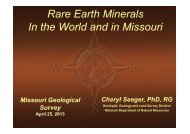You also want an ePaper? Increase the reach of your titles
YUMPU automatically turns print PDFs into web optimized ePapers that Google loves.
Moonstone Formation Reefs, SW¼SE¼ sec. 24<br />
and NE¼NW¼ sec. 25, T. 30 N., R. 90 W.,<br />
Southeastern Fremont County<br />
Sandy, calcareous, partly silicified tuffaceous knobs<br />
or humps that project above the relatively flat-ly<strong>in</strong>g<br />
Moonstone Formation are present <strong>in</strong> this vic<strong>in</strong>ity.<br />
Love (1961; 1970) suggested these knobs were<br />
possible algal reefs. However, they conta<strong>in</strong> no fossil<br />
material and appear to be hot-spr<strong>in</strong>gs-related tufa<br />
deposits. Several small, historical prospect pits are<br />
dug <strong>in</strong>to the mounds that exhibit radioactivity<br />
that is notably higher than the local background;<br />
the radioactivity appears to be concentrated along<br />
silicified fractures. Brecciation along apparent fractures<br />
is evident <strong>in</strong> two of the largest knobs. Sample<br />
20120918WS-D, collected from a knob <strong>in</strong> sec. 25,<br />
conta<strong>in</strong>s greater than 1,000 ppm Thorium. Sample<br />
20120918WS-G, collected from a large knob <strong>in</strong><br />
sec. 24, conta<strong>in</strong>s 213 ppm thorium. No anomalous<br />
REE were detected.<br />
Strong M<strong>in</strong>e, Sec. 4, T. 16 N., R. 71 W., Southern<br />
Albany County<br />
The orig<strong>in</strong>al m<strong>in</strong>e <strong>in</strong>cluded a 110 m (360 ft) shaft<br />
with five levels total<strong>in</strong>g at least 399 m (1,308 ft)<br />
of tunnels by 1907 (Beeler, 1907). The shaft was<br />
sunk <strong>in</strong>to fractured diabasic and gabbroic dikes<br />
hosted by layered gneiss and schist <strong>in</strong> granite and<br />
anorthosite (Hausel, 1997). Tungsten was targeted<br />
<strong>in</strong> scheelite deposits at the 106.7 m (350 ft) level.<br />
One hundred tons of scheelite ore was shipped to<br />
Boulder Colorado, and yielded 0.2 to 0.6 percent<br />
figure 27. WSGS geologist Robert Gregory collect<strong>in</strong>g<br />
sample 20120913BG-3 from altered, brecciated granite,<br />
a road cut along the Leo-Shirley Bas<strong>in</strong> Road; details are<br />
<strong>in</strong> the Appendix CD and on Wyo-DOG. Photo by Wayne<br />
M. Sutherland.<br />
65<br />
WO 3 (Hausel, 1997). Gold, silver, and nickel<br />
were also recovered from the m<strong>in</strong>e (Beeler, 1942).<br />
A grab sample of sheelite- and pyrite-bear<strong>in</strong>g<br />
quartz-potassium feldspar-biotite gneiss (Sample<br />
19710416ST-3) conta<strong>in</strong>s 5,820 ppm tungsten, but<br />
no REE enrichment.<br />
Unnamed Location, South Pass Area, SE¼ sec.<br />
23, T. 29 N., R. 98 W., Southwestern Fremont<br />
County<br />
A sample of black, very f<strong>in</strong>e- to f<strong>in</strong>e-gra<strong>in</strong>ed quartz<br />
biotite schist, cut by a white, f<strong>in</strong>e-gra<strong>in</strong>ed quartz<br />
ve<strong>in</strong> with epidote, chlorite, and scheelite (Sample<br />
20121212WSGS-B) conta<strong>in</strong>s 5,190 ppm tungsten,<br />
0.15 ppm gold (0.004 oz/ton), and 0.23 ppm<br />
(0.007 oz/ton) silver.<br />
Broadway M<strong>in</strong>e, SW¼ sec. 32, T. 13 N., R. 83<br />
W., Southeastern Carbon County<br />
Reclamation efforts at the Broadway m<strong>in</strong>e site have<br />
destroyed observable field relationships and vehicle<br />
access to the m<strong>in</strong>e site (Hausel, 1992). Production<br />
at the Broadway m<strong>in</strong>e targeted a sheared zone<br />
at the contact between granite and a complex of<br />
gneiss, amphibolite, pyroxenite, gabbro, and diorite<br />
that dips from 50° SE to 50° NW (Osterwald,<br />
1947; DeNault, 1967). Sample 20121203WSGS-<br />
A from this m<strong>in</strong>e is a green, medium- to coarse<br />
gra<strong>in</strong>ed diopside spessert<strong>in</strong>e hornfels with m<strong>in</strong>or<br />
act<strong>in</strong>olite, and moderate to abundant limonite<br />
sta<strong>in</strong><strong>in</strong>g and gra<strong>in</strong>-coat<strong>in</strong>gs. The sample conta<strong>in</strong>s<br />
2.75 percent z<strong>in</strong>c but no REE enrichment.



